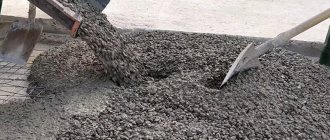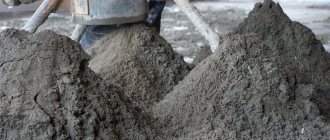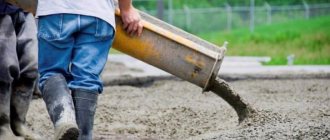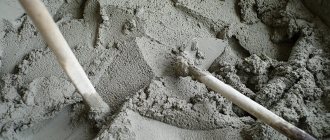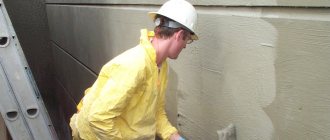We understand the contents of concrete, what elements should be present, and what each of them is needed for. How to make concrete, how to mix concrete by hand, proportions for making the mixture and why they may differ. Let's look at how to change the strength, frost resistance, moisture resistance and elasticity of a concrete mixture. Types of concrete: in which works is M-100 used, and in which M-500, also what do these digital values mean?
Proper concrete is the key to a strong structure Source img.aviarydecor.com
What to make a mixture from
Concrete today is an absolutely indispensable product in general construction projects. Let's figure out what concrete is made of. Among its components are small and large particles mixed together with liquid cement (cement paste), which hardens over time. The concrete mixture contains 4 main components. Sometimes additional elements may be present. Let's look at them to figure out how to properly prepare concrete.
Elements of a cross Source dom-dacha-svoimi-rukami.ru
The basic elements that combine all the remaining ingredients into a coherent structure are cement and water, but this paste is unstable in size. Consequently, if the paste content increases, the concrete becomes susceptible to severe creep and shrinkage. Other components provide dimensional stability.
Now, according to particle packing theory, the gaps in the coarse aggregates should be filled with an abundance of fine aggregates, and the remaining gap in the mixture with paste. This guarantees a reliable, efficient and dimensionally stable crossbreed.
The quality factor of concrete is directly determined by the properties and amount of cement. The mineralite instantly sets and becomes hard as stone, even from unintentional contact with water. It is also appropriate to pay attention to the physical properties of such a mixture. Without additional impurities, the quality of concrete is significantly lower than with them. The element reacts upon contact with water and other ingredients to create a solid matrix that binds the components together into a durable, stone-like product that has many uses.
Dry cement Source dom-kirpicha.com.ua
The most common brands of this product in private construction are M-400 and M-500.
Let's talk about the harshness of this product. It is easy to determine by the way the mixture flows: if the product flows down a horizontal surface, then it is too plastic, if when tilted, it is moderately plastic, low-plastic if it sticks and does not slide down, and hard - when the mixture remains one clot without settling.
When making concrete mixtures, small crushed stone is used - up to 12 mm, up to 40 mm. For floor screeding and non-volume work, granite screenings or chips are used.
Crushed stone for concrete mix Source www.stroi-baza.ru
Let's look at what crushed stone is like:
- Limestone is suitable for use inside buildings; outdoors this material falls apart quite quickly.
- Gravel is very popular because it is highly durable and easy to work with.
- Granite is a very durable filler, famous for its low water absorption and high resistance to frost.
Sand is divided into 5 types according to size: from 1.2 mm - with small particles, to 3.5 mm - coarse-grained. Sand with fine grains is used in construction for lightweight concrete, while sand with large grains is considered more universal.
One of the ingredients is sand Source ak6.picdn.net
Sand for making a mixture can also be divided into soft and sharp. A soft mineral has a smoother surface on individual particles. This is natural sand that was formed by erosion factors such as the movement of water on the beach. Sharp sand particles have a rough surface. This sand is the result of production by crushing large forms of aggregate. The most important factor regarding the sand used in mixing concrete is that the mineral must be pure. Impurities in the product, such as silt or organic matter, will weaken the finally cured concrete. In addition, sand is considered one of the most economical components of the mixture.
Admixtures are products in powder or liquid form that are added to concrete to give it certain characteristics that cannot be obtained with simple concrete mixtures. The most common impurities are retarders and accelerators. In normal use, additive dosages are less than 5% by weight of cement and are added to the mixture during mixing.
Additives for concrete Source grand-markt.ru
See also: Catalog of house projects for permanent residence
Accelerators speed up the hydration (thickening) of concrete. Typical elements are calcium chloride, calcium nitrate and sodium nitrate. However, the use of chlorides can cause corrosion in steel reinforcement, so nitrates are preferred, even though they are less effective than chloride salts. Accelerating admixtures are especially useful for modifying the properties of concrete in cold weather. They trap tiny air bubbles in the concrete, which reduces damage during freeze-thaw cycles, increasing durability.
Retarders retard the setting of concrete and are used in large or complex pours where partial setting before completion of the pour is undesirable. Typical additives here are sugar, sucrose, sodium gluconate, glucose, citric acid and tartaric acid.
The plasticizing admixture makes the mixture more mobile, strength is achieved with a relatively small amount of cement, and this saves you money. But it is necessary to take into account that impurities affect the hardening time and initial strength gain.
There are also additional antifreeze additives. True, they will not be cheap - the dosage that will allow you to work down to -20 °C costs as much as concrete itself.
Aestheticians use pigments to change the color of the finished product.
Pigments for concrete Source www.omkarindus.net
In normal condition, at room temperature 15-20 °C, in 3 days the prepared and poured mixture will harden to approximately 30% of the design strength, in 7 days - by 70%, and after 28 days it will reach 100%. As the temperature decreases, the dynamics of strength gain decreases. The material will naturally gain absolute strength, but this process will take more time.
Mixed concrete components used in large commercial or government projects such as road construction, residential construction, must meet stringent standards for size and cleanliness. The strongest product is obtained from filled material with markings. This means that the coarse aggregate sand mixture consists of granules and gravel of all sizes, so the concrete mixture has uniform voids between the aggregate particles. They are filled with cement to give the finished product a uniform structure.
Properties and characteristics
Dry concrete has the following properties:
- increased strength, high degree of adhesion;
- withstands mechanical stress;
- does not collapse over time;
- high vapor permeability allows accumulated condensate to be quickly removed outside;
- not afraid of sudden temperature fluctuations;
- frost-resistant.
Characteristics of dry concrete:
- does not contain wet elements;
- long shelf life;
- no restrictions on transportation;
- does not require additional impurities, everything is already ready.
Figure 5
The ratio of elements in the mixture
The safest ratio for a concrete mixture is considered to be 4:2:1: 4 parts stone; 2 parts sand; and 1 part cement. The 4-2-1 mix is obviously composed of seven parts. It is convenient when, when mixing the components, the ratio can have any range of scales. For example, 4 full shovels of stone, 2 sand and 1 cement; 4 10-liter buckets full of crushed stone, 2 with sand and 1 with cement; or 4 loader buckets filled with stone, 2 with sand and 1 with cement. In kilograms this is 300/1250/600 kg and 180 liters. water.
Concrete mixture Source beton-house.com
See also: Catalog of companies that specialize in foundation work
However, a 4:2:1 ratio is ideal in few situations. In projects that require extreme compressive strength, larger amounts of crushed stone are needed and a ratio of 5:2:1 should be used. For projects that don't need a product with great compressive strength but do need a high degree of workability—like a garden fountain—it's better to use more sand but less stone: a 2:4:1 mix, for example.
This proportion can be changed based on what brand of product is ultimately needed, what brand of cement, sand and crushed stone is used, as well as on the quantity and type of additives. For example, the ratio of elements in the foundation is approximately the following: cement - 1 part, crushed stone - 5 parts, sand - 3 parts.
It is easy to calculate how much water should be added to the mixture based on the outside air temperature, humidity, the presence or absence of direct sunlight and the proportions of the mixture itself. The most important thing to remember about water is that the more it is in proportion to the other components of the mixture, the weaker the finished product is in tensile strength and adhesive strength. Ideally, the least amount of water is best if strong adhesion is a high priority.
But, again, sometimes situations arise where workability is a higher priority than structural integrity, and water is the secret to performance.
Liquid concrete Source lajomar.com.br
What you definitely need to remember about determining the required proportions:
- the more stone, the greater the compressive strength of the mixture: the more sand, the higher the workability;
- adhesion (cement) and compressive strength (stone) are two different indicators of the properties of a mixture: more cement does not mean greater compressive strength, it means more tensile strength;
- the less water, the stronger the adhesion of the cement, but the more difficult it is to work with the finished mixture.
Composition and proportions
Dry concrete contains the following structural components:
- Portland cement with a strength of at least M400;
- sand;
- granular compactor with a fraction size of no more than 20 mm;
- additional additives (limestone, plasticizer, moisture-repellent substances).
To reduce the weight of concrete, manufacturers may include the following types of materials:
- Natural:
- pumice;
- calcareous rocks, shell rock;
- volcanic rocks (various slags, tuff).
- Artificial:
- perlite, vermiculite;
- expanded clay, agloporite;
- foamed polystyrene.
- Industrial waste:
- fuel and animal waste.
Concrete marking
For the marking value, the letter M and numbers from 75 to 1000 are used, which indicate the calculated resistance of concrete to its compression (measured in kgf/cm2) when it completely hardens, that is, after 28 days. The higher the digital value in the marking, the stronger and more durable the concrete:
- M-100 and M-150 - used for the construction of pillows under the foundation;
- M-200 is the most common, used for pouring foundations, floor screeds, constructing retaining walls, blind areas and paths;
- M-250 and M-300 are intermediate grades between M-200 and M-350;
Dry concrete mixture Source i2.wp.com
- M-350 is the most popular brand, which is used for the construction of monolithic foundations, load-bearing structures, and road surfaces;
- M-400 and M-450 are rarely used, mainly in the construction of hydraulic structures;
- M-500 and M-550 are used for the construction of objects to which special requirements apply (these are dams, dams, subways, etc.).
Mixing methods
The preparation of concrete mixture is carried out in two ways:
Manual kneading
Many people are mistaken in believing that mixing by hand requires a container - no, preparation is carried out using a board made of boards; they also use metal, tin boards, troughs made of various materials; the concrete mixture is mixed even just on a flat, hard surface. If the shield is constructed from boards, they need to be tightly fitted and, ideally, covered with roofing iron, although you can simply knead it on a sheet of such iron with the edges slightly turned inward.
First, sand is poured in a heap along the length of the shield, a furrow is made in the center, cement is poured there, the sand is rolled in little by little from top to bottom, stirring gradually. Next, sand and cement are mixed 3-4 times using two shovels, then everything is moistened with water from a watering can and mixed again. Next, gravel is poured evenly, the mixture is stirred at the same time, and water is added little by little until the required consistency is formed.
Another sequence: cement - water - sand - gravel (crushed stone).
How to make a crossbreed
Option 1
Let's look at how to prepare limestone concrete at home, what the proportions will be:
- Break the limestone into 5-10 cm pieces with a sledgehammer. You can tell if a stone is limestone by dropping vinegar on it; if it hisses and cracks, it is limestone. Industrial limestone companies use mechanical crushers or hammer mills to crush limestone. Limestone-based Portland cement can also be purchased online, at hardware stores and garden centers instead of making it yourself.
- Mix universal sand with cement in a ratio of 2:1 in a wheelbarrow using a shovel. Universal sand can be ordered online or purchased at a hardware store. If it is possible to use a concrete mixer, it is better to use it instead of a shovel and wheelbarrow.
Concrete in a wheelbarrow Source i.ytimg.com
Handmade recipe
Let's consider the option of how to prepare a concrete mixture for home construction manually, based on the proportions in the tables. Here are two tables, using which you can determine the proportions and number of components for 1 cubic meter of solution.
Table of water-cement ratio (average indicators of aggregates):
Table - Ratio of water and cement
| Concrete, brand | V/C | |
| Cement M400 | Cement M500 | |
| 100 | 1.04 | — |
| 150 | 0.86 | — |
| 200 | 0.70 | 0.80 |
| 250 | 0.58 | 0.66 |
| 300 | 0.54 | 0.62 |
Calculation of water for filler per cubic meter. m and the percentage of sand in it.
Table - Ratio of sand, crushed stone and water
| Crushed stone, mm | Volume of sand in% in solution | Water per cubic meter, in l. |
| 10-12 | 54 | 231 |
| 15 | 51 | 221 |
| 20 | 48 | 201 |
| 25 | 45 | 196 |
| 40 | 42 | 186 |
| 50 | 40 | 178 |
| 70 | 36 | 168 |
You also need to know the approximate density of the fillers, weight in kg/m2:
Preparation of concrete M300 (1 cubic m). Ingredients:
The first table determines W/C - 0.54; the second is the amount of water, with this filler you need 196 liters. Cement: 196/0.54=363 l. Volume and percentage of filler: 1- ((363/3000)+0.196)=0.680 m3. We look at the percentage of sand according to the second table - 45%, which comes out to 680 × 0.45 = 306 liters of sand. Crushed stone: 680–306=374 l.
The volumes were determined in liters, so you can work with a 10 liter bucket. If the supplier measures fillers in tons, then it is easy to convert them into liters using the above weight-volume density values in kg/m2 (for cement you need to take the bulk density).
Types of additives
Depending on the composition and the additives included in it, the set of characteristics varies, as well as the price of the finished mixture. Common types of additives are presented in the table:
| Color pigment | Added to give the mixture the required shade. This additive is used in concrete intended for finishing work both indoors and outdoors. |
| Antifreeze additive | Strengthens the viscosity of concrete at low temperatures. |
| Epoxy component | Increases the coefficients of hardness, water resistance and ductility. |
| Water repellents | They allow the manufacture of reservoirs for swimming pools, home ponds, as well as laying underground foundations in areas with high humidity, where groundwater comes relatively close to the surface of the earth. |
| Various plasticizers | Serve to thin the mixture without adding more liquid in order to simplify the use of the solution. |
| Additives to change the rate of hardening | Inclusions that slow down and accelerate the setting process of concrete. |
The advantage over a highly specialized focus is, of course, the versatility of the mixture. This material is in great demand among buyers.
What is it used for?
They use a high grade to repair airport runways.
Dry concrete is used for laying foundations, blind areas and wear-resistant floors. As an auxiliary material, the mixture is used to prepare foundations for basements, garages, workshops, and workshops. Dry concrete mixtures are suitable for pouring concrete, plastering walls and facades, laying bricks, waterproofing, finishing reinforced concrete products and concrete structures. High grades of dry mixtures are used for repairing highways and airport runways.
Dry concrete is ideal for small jobs in confined spaces. This allows you to save money on organizing a full-fledged construction site with expensive equipment.
Return to contents
Benefits of mixtures
In contrast to independently mixing all the components of a concrete solution - cement, sand, fillers and various additives, the use of ready-made semi-finished products has many undeniable advantages. The following can be highlighted:
- Minimum required area for construction . There is no need to provide access to the construction site for unloading material - crushed stone, sand, gravel, etc. The costs of delivering construction materials are reduced several times. In addition, during private construction there is a risk of damage to plantings on the site - trees, shrubs and flower beds. Preparing a solution from a concrete semi-finished product will take up very little space and will simplify cleaning after work without damaging the surrounding vegetation.
- Quality guarantee of the finished product . To prepare concrete from individual components, you will have to carefully follow the instructions, but the worker still risks making mistakes, which will negatively affect the strength of the structure. When using a ready-made mixture, there are manufacturer guarantees regarding the quality of its products.
- Reducing costs . Mixing the finished product with water in a certain proportion is not difficult for one person, in addition, it will save time and effort.
- Ease of use . The purchased mixture retains its properties for six months, therefore, you can use it all this time to carry out both large and small repairs, without mixing many components each time and without calculating the required quantity.
Thus, the use of ready-made dry factory mixtures guarantees high quality, ease of use and cost savings.

